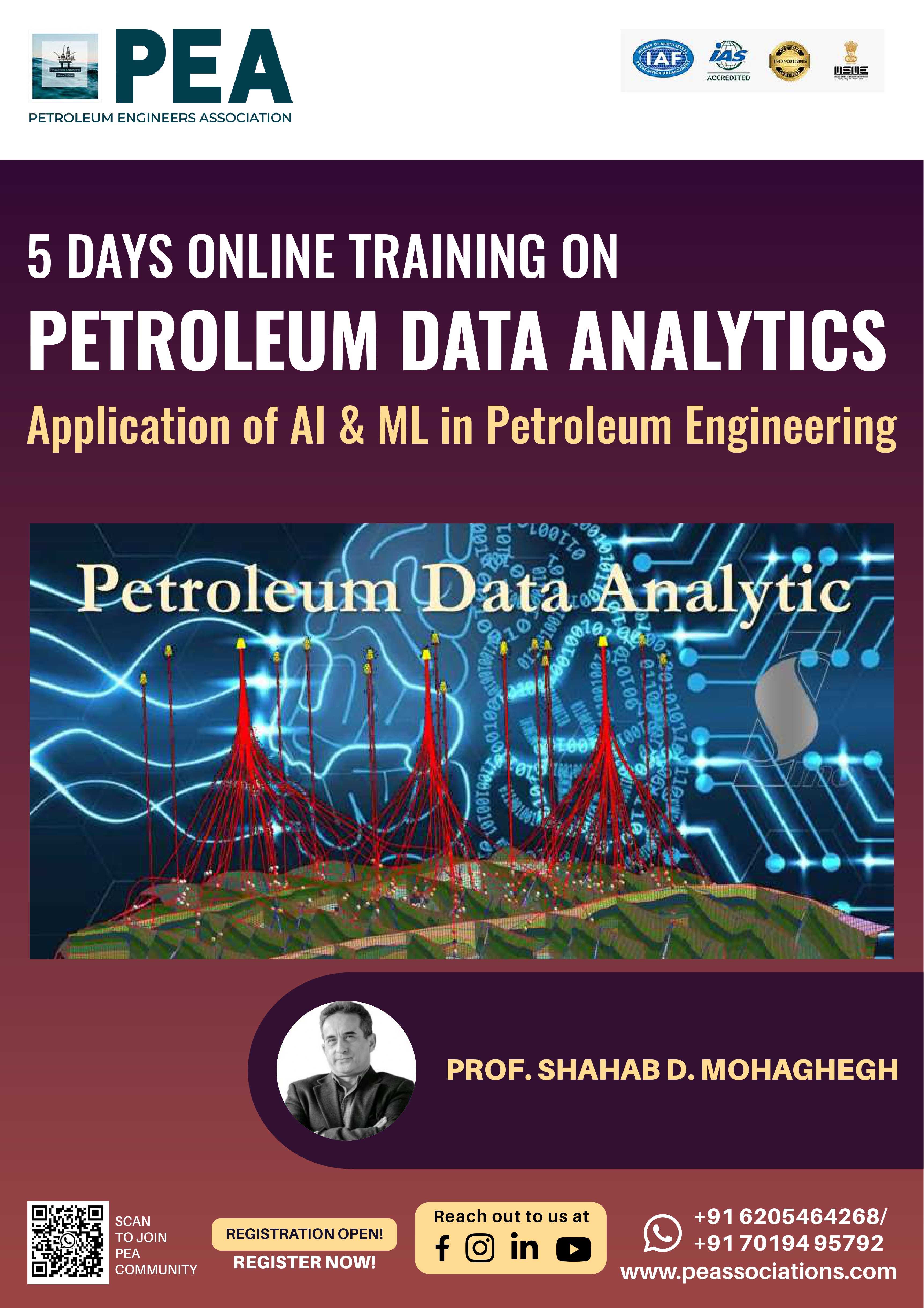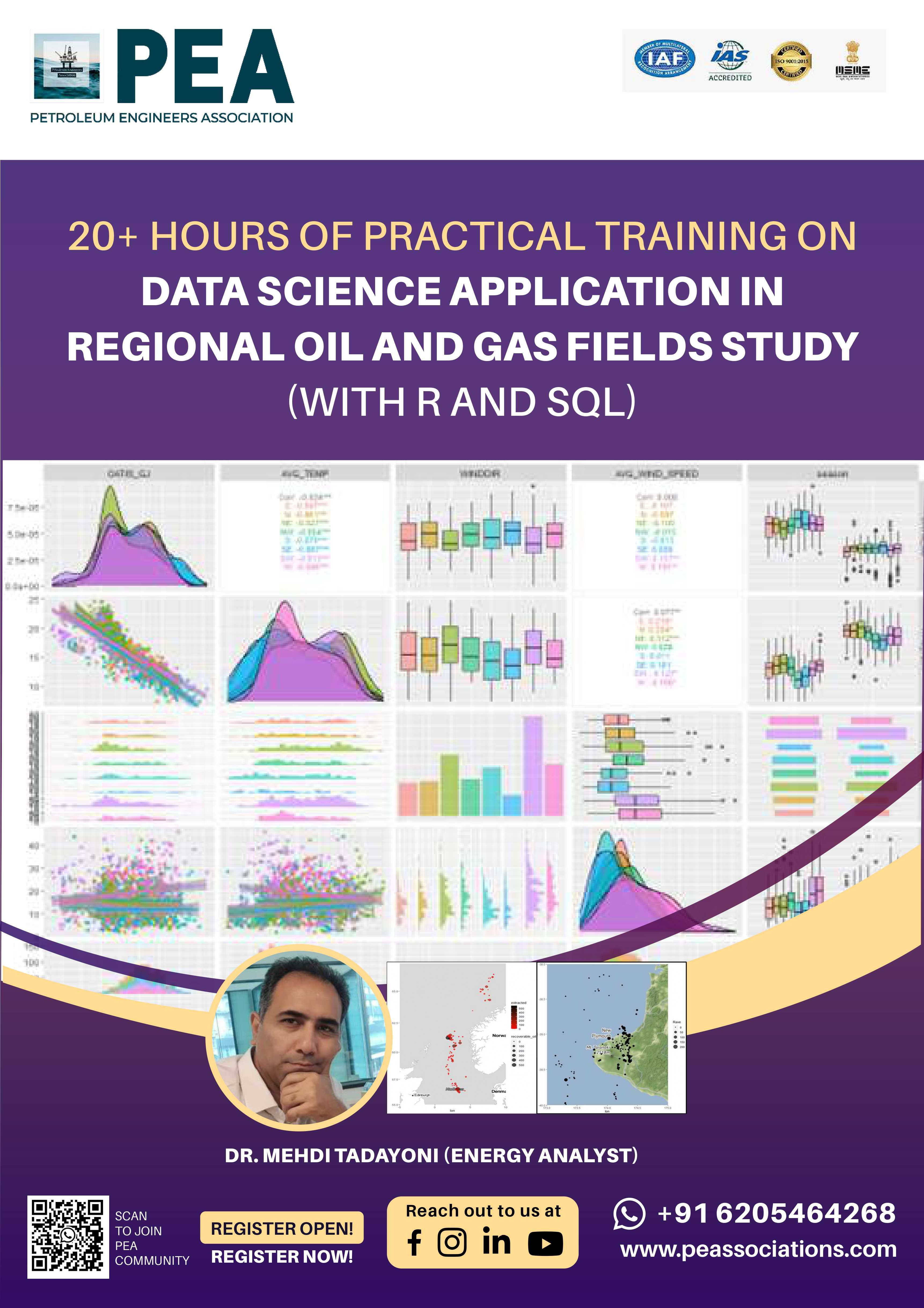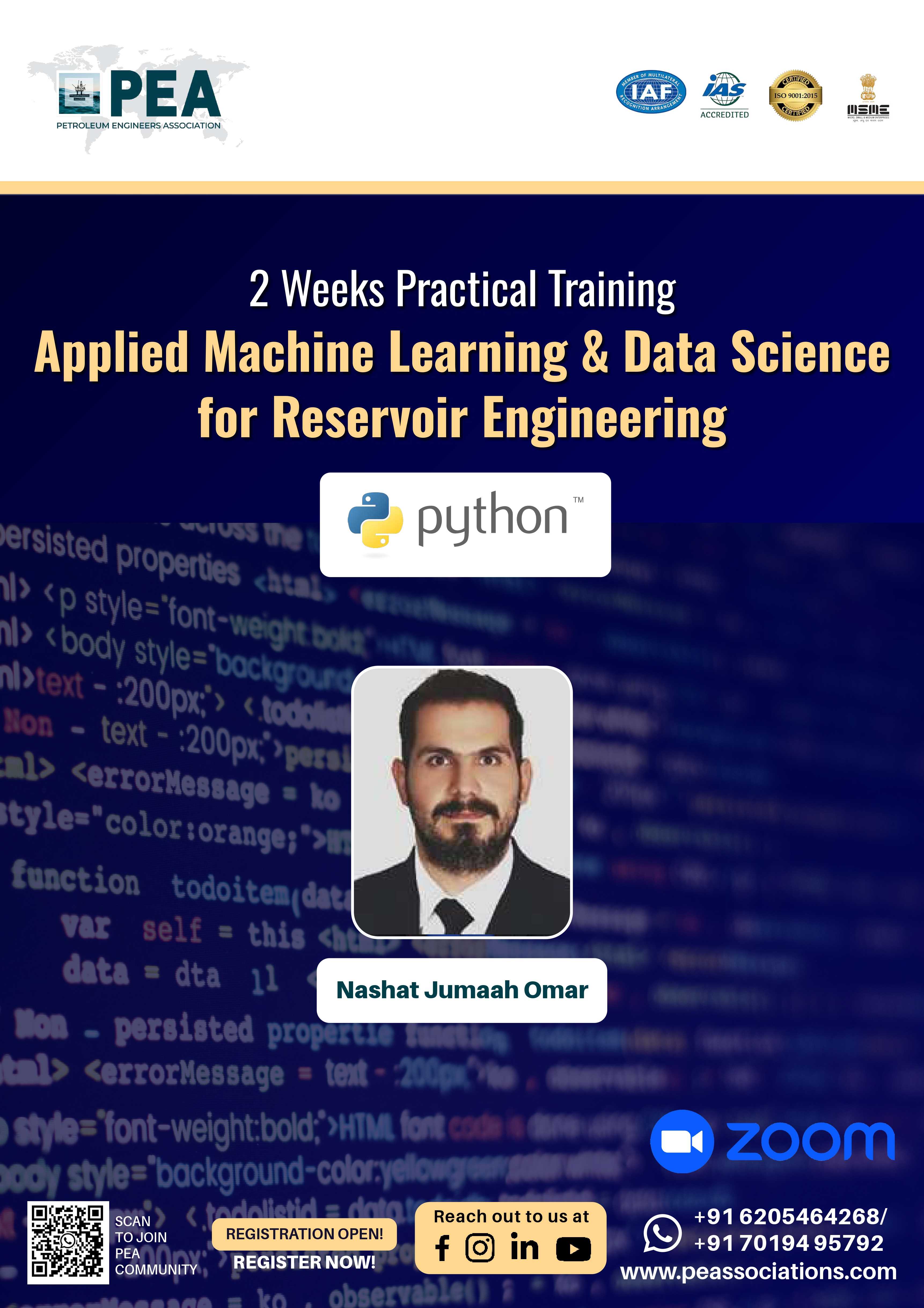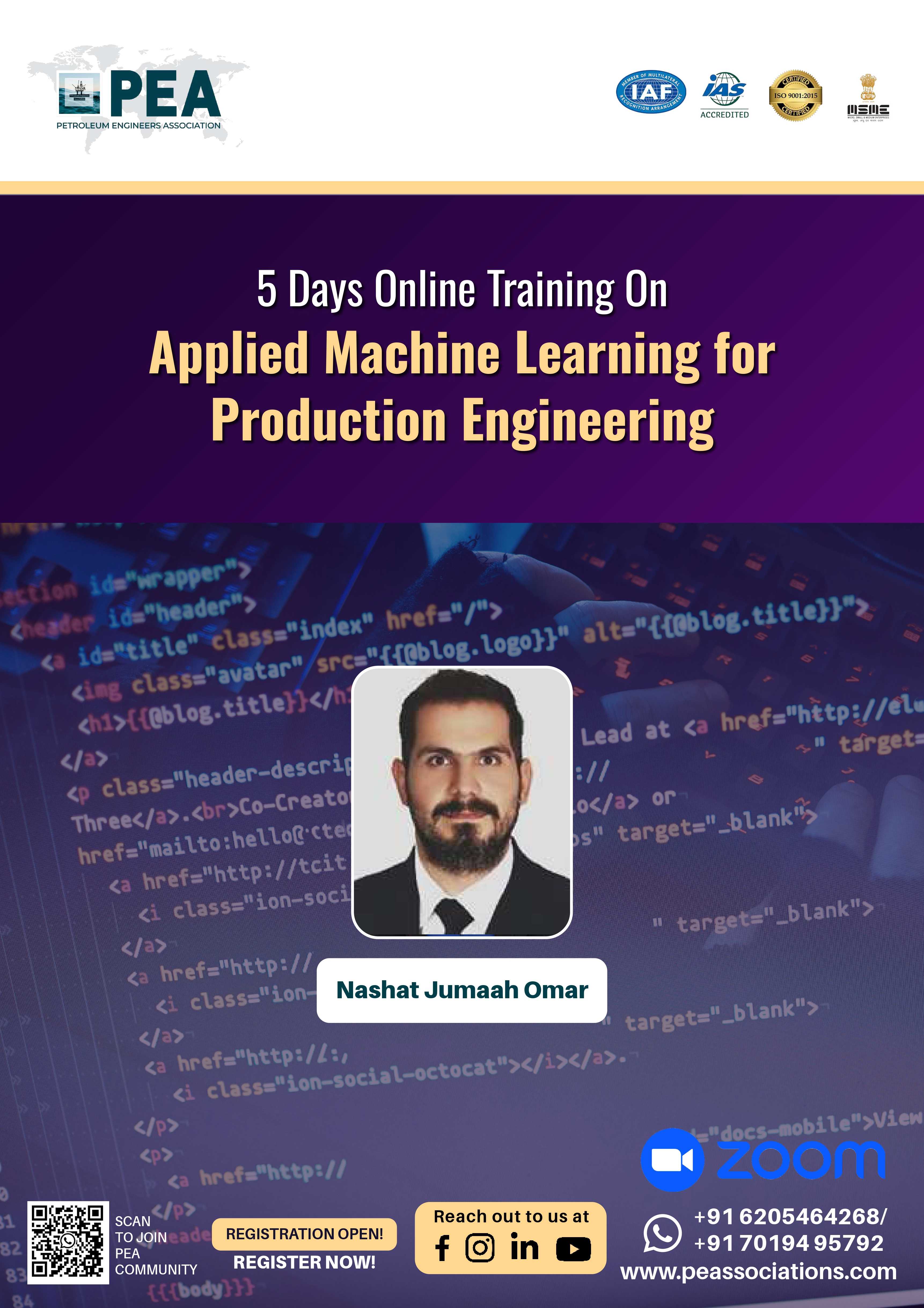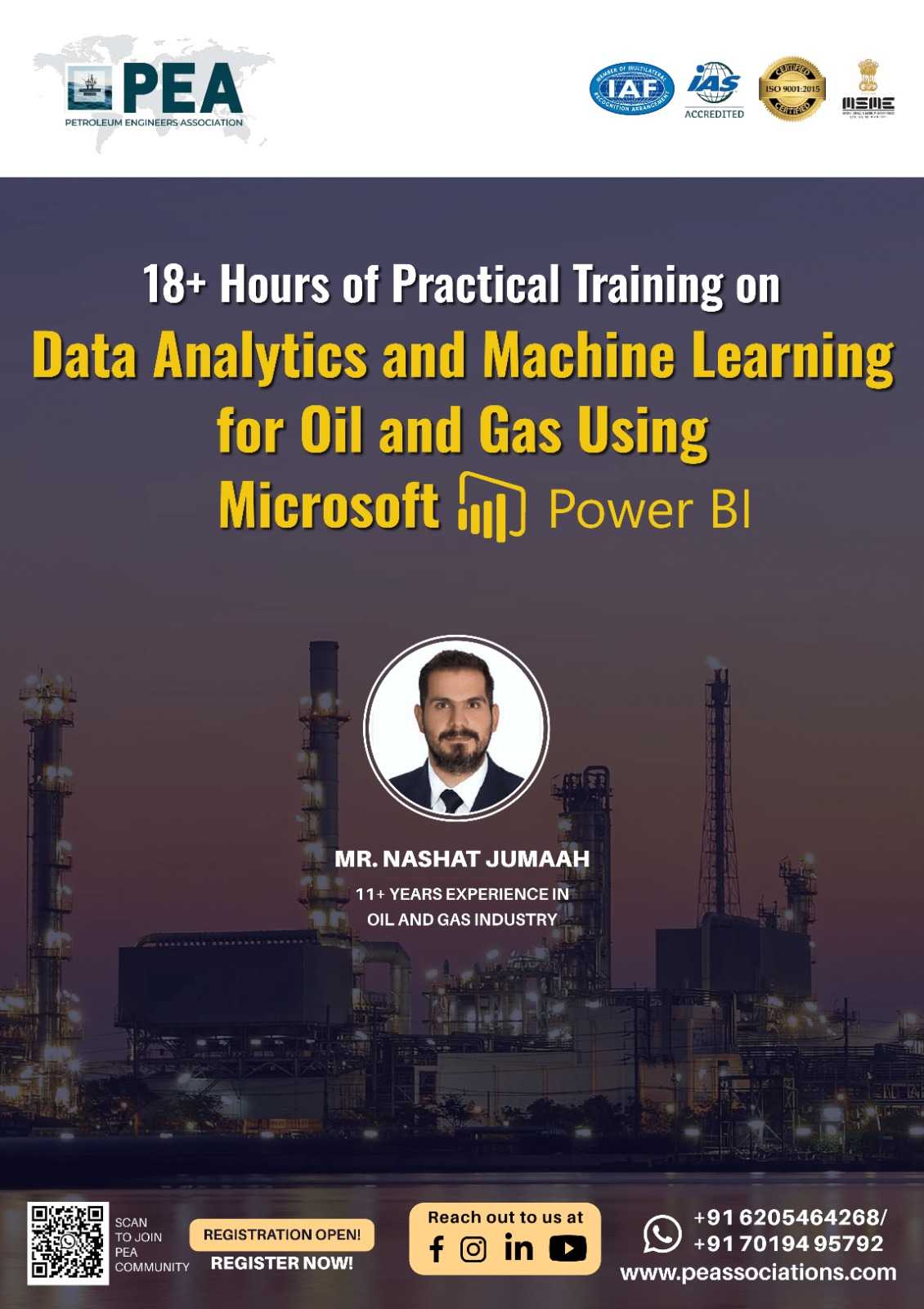| Code | Date | Time | Duration | Location | Currency | Team of 10 Per Person | Team of 7 Per Person | Early Bird Fee Per Person | Normal Fee Per Person |
|---|---|---|---|---|---|---|---|---|---|
| PEAMLRP25 | 10 - 23 Nov 2025 | 9 PM Indian Time |
3 Hours Per Day
|
Zoom Online
|
USD
|
1500
|
1650
|
1850
|
2500
|
Boost your team's skills and your budget! Enjoy group discounts for collaborative learning. Send an inquiry to info@peassociations.com.
Machine Learning for Reservoir and Production Engineering
This course introduces reservoir and production engineers to the principles and applications of machine learning, enabling data-driven decisions for optimization and improved efficiency in oil and gas projects.
Description
In the rapidly evolving landscape of oil and gas, data-driven techniques are transforming traditional approaches to reservoir and production engineering. This course delves into the fundamentals of machine learning, focusing on real-world applications tailored to the industry. Participants will learn to apply machine learning models to analyze complex reservoir and production data, streamline operations, and enhance decision-making processes. The training combines theoretical foundations with practical exercises, empowering engineers with the tools to leverage machine learning effectively in their daily tasks.
The oil and gas industry generates vast amounts of data daily, from reservoir modeling to production monitoring. However, extracting meaningful insights from this data requires specialized knowledge in machine learning. This course is designed to bridge the gap, equipping reservoir and production engineers with essential machine learning skills to improve decision-making and operational efficiency.
Understand the fundamentals of machine learning and its role in reservoir and production engineering.
Explore data-driven methods for optimizing reservoir management and production workflows.
Develop skills to preprocess, analyze, and model oil and gas data using machine learning techniques.
Learn to implement supervised and unsupervised machine learning models for various field applications.
Apply machine learning methods to enhance predictive capabilities for reservoir behavior and production performance.
This course combines theoretical instruction with hands-on practice, using industry-relevant datasets to simulate real-world scenarios. Participants will work on guided exercises and case studies to reinforce learning and apply techniques directly to reservoir and production challenges.
Upon completing this course, organizations can expect their engineers to bring new skills and perspectives, leveraging machine learning to enhance operational efficiencies, optimize reservoir management, and improve production forecasting. This translates into better resource management and decision-making aligned with data-driven insights.
Participants will gain a comprehensive understanding of machine learning fundamentals and hands-on experience in applying these techniques to reservoir and production challenges. This skill set enables engineers to drive data-informed decisions, boost their professional capabilities, and remain competitive in the industry.
Petroleum / Reservoir / Production Engineers: engineers with a desire to automate processes, analyze large datasets, optimize operations, and make data-driven decisions using programming and machine learning techniques would be the primary audience. This includes engineers involved in reservoir modeling, production optimization, drilling engineering, and more.
Technical Managers: Managers overseeing technical teams
could benefit from understanding the capabilities of Python and machine
learning to guide decision-making and project planning in the petroleum
industry.
Students
and Researchers: Students studying petroleum engineering or related fields
could use this course to enhance their technical skills and gain a competitive
advantage in the job market. Researchers interested in applying machine
learning to solve industry challenges could also benefit.
Module 1: Petroleum Engineering Data
Integrated Production System
Types of Petroleum Engineering Data
Introduction to Python for Oil & Gas Industry
Introduction to Python
Python Tools & Package Options
Anaconda Navigator
Python IDEs (VS Code, Spyder, Jupyter Notebook, etc.)
Data Types & Exploratory Data Analysis
Data Pre-processing
Python Data Types & Basic Python Functions
Variables, Expressions, and Statements
Values and Data Types
Statements and Expressions, Operators
Lists, Indexing & Slicing
Data container (Lists and Dictionaries)
Operation on Containers
Introduction to Loops
Introduction to Branching (IF Statements)
Complex Data Structures & Control Flow
Dictionaries
Conditional Statements
For Loops
Creating Functions
Module 2: Python Data Analysis & Visualizations
Data Manipulation using Numpy and Pandas
Data Analysis & Visualizations
NumPy
Panda
Matplotlib
Scipy
Seaborn
Descriptive Statistics
Methods to impute missing values
Outlier/Anomaly Detection
Data Visualization
Histogram
Bar Graph
Scatter Plot
Pie Chart
Box Plot
Python Machine Learning Libraries
Scikit-learn Machine Learning Algorithms.
Workflow of the Machine Learning Model
Deploy Machine Learning Models as Interactive APIs.
Supervised and Unsupervised Learning
Model Evaluation and Validation
Classification and Regression Algorithms
Unsupervised Learning
K-Mean Clustering using Scikit-learn
Clustering Oil wells based on petrophysical properties
Clustering Gas Wells Based on Liquid Loading Index
K Nearest Neighbors
Random Initialization
Choosing the Number of Clusters
Hierarchal clustering and Dendrogram
Hierarchal Cluster for Water Cut
Correlation matrix and Heat map
Under-fitting vs Over-fitting
Bias-Variance Trade-off
Classification Techniques
Logistic Regression
Support Vector Machines (SVM)
Decision Tree
Random Forest
Module 3: Supervised Learning
Supervised Learning
Neural Network Architecture and Components
Activation Functions in Neural Networks
Backpropagation and Optimization Algorithms
Hydrocarbon Phase Behavior
Analysis of Reservoir Fluid Properties
Prediction of PVT Data using Machine Learning Techniques
Permeability Measurement Techniques
Permeability Prediction Techniques
Applications of Artificial Neural Networks for
Core-Calibrated Permeability Predictions using the Petrophysical Data.
Module 4: Production Data Analysis & Reservoir Surveillance
Time Series Analysis with AI
Time Series Data and Its Characteristics
Long Short-Term Memory (LSTM) Networks for Time Series
Evaluating Time Series Models
Production Analysis Dashboards
Optimization of Surface Network Models using Machine
Learning
Case Studies and Examples
Streamlit Library
Designing Dynamic Python Applications with Streamlit
Interactive Web Applications & Dashboards
Enhancing User Experience with Streamlit Layout Features
State Management and Dynamic Interactions with Streamlit
Module 5: Machine Learning and Computing
Introduction to Machine Learning vs. Traditional Computing
Impact of the AI Revolution on Petroleum Engineering
Deep Learning Python Libraries Tensorflow and PyTorch.
Module 6: Applications of Machine Learning in the Petroleum Industry
Artificial Neural Networks: Definitions, Architectures,
Types, Training, and Validation.
Overview of Machine Learning Applications in the Petroleum
Industry
Machine Learning Projects in Various Petroleum Engineering
Aspects
Machine Learning Workflows
Supervised vs. Unsupervised Learning Techniques
Module 7: Programming Tools and Basics & Python Fundamentals and Dashboard Creation
Useful Tools for Efficient Coding
Setting Up Your Development Environment: Anaconda
Distribution
Introduction to Python Programming Basics
Hands-on Practice: Python Basics using Jupyter Notebook
Recap of Python Fundamentals
Python Libraries for E&P
Visualizing and Presenting Data Insights
Python Project 1: Create Dashboard for Nodal Analysis &
Vertical Lift Performance (VLP) Calculations
Module 8: Data Analysis & Transformation
Hands-on Project: Data Analysis with Real Petroleum Industry
Data
Handling Data from Various Sources: Files and Formats
Data Cleaning and Preprocessing Techniques
Estimating Missing Data and Data Transformation Methods
Machine Learning Project 2: Drilling Data Optimization
Machine Learning Project 3: Pump Intake Pressure Estimation
using Regression Techniques
Machine Learning Project 4: Flow Rate Estimation from Pump
Intake Pressure
Simple Model Dashboard: Create simple data input dashboard
uses the trained model and generates the outputs.
Module 9: Machine Learning Projects (Regression)
Introduction to Regression Machine Learning Methods.
Machine Learning Project 5: Learning for Oil Properties
Estimation: Oil FVF or Viscosity
Classification Machine Learning Methods.
Machine Learning Project 6: Decline Curve Analysis (DCA)
& prediction.
Machine Learning Project 7: Well Logging Analysis Dashboard & Core-calibrated Permeability Predictions.
Module 10: Machine Learning Projects (Classification) & Time Series Analysis
Machine Learning Project 8: Rock Typing & Hydraulic Flow
Units (HFU) Prediction.
Machine Learning Project 9: Flow Assurance & Scale
Formation Prediction using Classification Techniques
Machine Learning Project 10: Predicting Production Performance using Time series.
On successful completion of this training course, PEA Certificate will be awarded to the delegates
Hesham Mokhtar is a Reservoir Engineering Team Leader at General Petroleum Company (GPC) in Egypt. He has extensive experience in reservoir management, characterization, and production optimization. He is skilled in using various software for reservoir simulation and analysis. He has also delivered training courses on waterflooding, PVT analysis, reservoir simulation, and more.
- 14+ years of Petroleum Engineering expertise delivering technical solutions to E&P portfolios.
- Expert in reservoir evaluations, log interpretations, and hydrocarbon estimations using tools like Techlog, Volumetric, DCA, MBE, OFM, and KAPPA
- Analyzes production data, material balance, RFT/MDT data, and pressure transients for reservoir performance and optimization.












